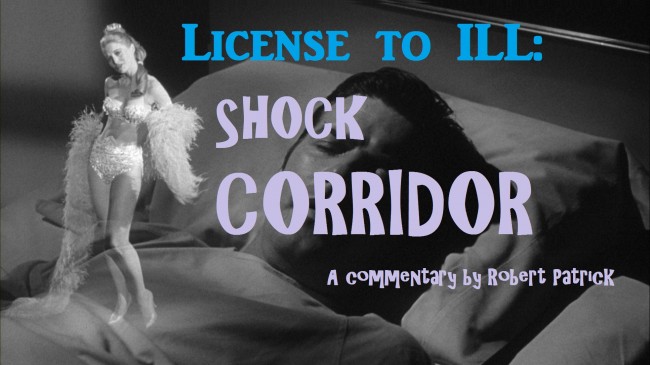License to Ill: Shock Corridor

“Shock Corridor” buzzes and snaps, jostles your cerebral cortex and plays dominos with your expectations. In this monochrome world where sweat is the dew of molting sanity, Sam Fuller pumps the tires of this movie with characters that I wouldn’t expect to see in 2010, let alone 1963. The stogie chomping auteur really let the floodgates open with his bug-eyed tale of a reporter whose goal was to infiltrate a mental hospital, obtain a big story about the institution, and come back home and dunk his quill pen into a Pulitzer Prize winning story. The press would be hotter than a cattle iron. Fuller’s picture is really a phantasmagoria of grinding teeth and disarrayed hair; a melting pot of the eras prominent social issues being deep friend in Fuller’s batter of night-terror and impending doom. Anatole Litvak’s maudlin, overwrought expression of mental hospitals, shown in 1948’s “The Snake Pit”, was, in comparison to Fuller’s dystopian view of asylums, an innocuous gallery portrait no more offensive or provocative than a Norman Rockwell painting. Some of the visuals of “Shock Corridor” are aroused by beautiful camerawork and a kind of loose confidence that let Fuller and his team paint the corners of their film with a sort of tilted clairvoyance. “Shock Corridor” is unique in that the movie is a sonic towel-whip to the eardrum. The movie is entirely venomous, and its approach has rolled up sleeves; Fuller doesn’t approach the audience with his material, he blindsides them with a ringing gong. Often times the sounds of the film are unnerving – the screaming of the inmates are primordial and without clause – making the experience somewhat exhausting, visceral.
Most of the actors and actresses in “Shock Corridor” skydive without a parachute. There is a sense that Peter Breck, who plays the tormented undercover journalist, is letting his tongue flap away with the writhing motion of a wounded rattlesnake. I doubt there was a lot of inhibition in his performance, in particular, and especially with that of the cast of performers who played the hospital’s inmates. This sort of recklessness drags a jackhammer to the border of usual film boundaries, eventually smashing them clean. And while some of the plot meanders about, in a deliberately pulpy way, the manic and unhinged atmosphere reinforces its beams anytime the structure of the story seems to falter. By the end of the film, you sense that, in 1963, Fuller was cackling at anyone who would dare touch his works. Much later in film history, David Lynch’s “Eraserhead” will benefit from a certain spectral vision that Peter Breck’s character dreams up, while wincing his eyes during a fuzzy, erotic nightmare.
The supporting cast of characters have minds like splintered wood, and to describe them here, before you endure the movie, would be a cardinal sin. “Shock Corridor” isn’t mildly playful (“Girl, Interrupted); litigiously cryptic (“Shutter Island”); nor does it teeter on tainted humor (“One Flew Over the Cuckoo’s Nest”). And while the aforementioned features are all marvels in their own right, Fuller’s “Shock Corridor” whittles away any would be comic relief and ruthlessly plugs away at your senses. Not always a pleasure to watch, the 1963 film is an aesthetic wonderland where the camera is like another character, the sounds are reminiscent of one’s worst fears, and the social concerns of the day (which are still relevant) whiz by at a breakneck speed. Definitely one of the more enduring pictures of the 1960s, and one that, long after you see it, bubbles and pops in your mind.
